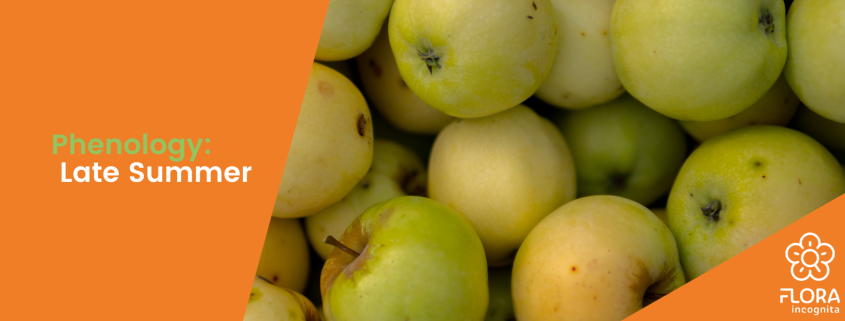Phenology: Late Summer – Harvest Season Begins
Every year, a clear chronological sequence of events such as the beginning of flowering, fruit ripening, or leaf coloring of specific plant species repeats itself. Thoroughly documented, phenology provides important data on the changes in regional climate – benefiting, for example, farmers who can adjust their tasks like sowing and harvesting according to the corresponding developments in plant life. Moreover, large-scale climatic changes can also be mapped using phenological data. Plant identifications with Flora Incognita assist in documenting phenology worldwide. Thank you for your contribution! The phenological late summer in Germany typically lasts only about 18 days. The official indicator of this season is the picking ripeness of early apple varieties, but there is much more to discover!
Early Apples are Ready to Pick
The White Transparent apple (Malus domestica), originating from Latvia, has been widespread in Europe since the end of the 19th century. This old variety is known for its early ripening from late July and its short shelf life: the fruits become mealy and spoil after about 2 weeks. For professional cultivation, the variety is no longer relevant, but it can still be found in many gardens. We are sure: many apple pies will be baked this year from the first White Transparent apples of the season. Other early apple varieties include James Grieve, Julka, Paradis Katka, Piros, and Retina.
Ripening of Serviceberries
The Serviceberry or Juneberry (Amelanchier lamarckii), native to the USA, is popular in Europe as an ornamental shrub due to its spring blossoms and magnificent autumn colors. Its almost black and sweet fruits ripen in late July and can be dried and used like currants. Unlike true currants, which are dried berries of the Corinth grape variety (Black Corinth), Juneberries belong botanically to the rose family. The Common Juneberry (Amelanchier ovalis), which is native to Germany, also ripens in July. Many birds love the small, dark fruits, but they are also a great choice for making jam or liqueur.
Rowanberries are Ripe
Rowanberries are the fruits of the mountain ash tree (Sorbus aucuparia). They ripen from August into early autumn. Botanically, they belong to the pome fruit family – if you examine a fruit closely, you will see that it looks like a tiny apple! Rowanberries often hang in clusters on the tree throughout winter and are an important food source for songbirds during this time. Did you know? Overripe fruits can develop significant alcohol content through the anaerobic fermentation of sugar components! For example, starlings or waxwings can easily tolerate a blood alcohol level equivalent to 0.3‰. Both their digestive tract and metabolism are adapted to this effect.
Heather is in Bloom
Late summer is also the time when heather (Calluna vulgaris) begins to bloom. This evergreen dwarf shrub can live up to 40 years and grow up to one meter tall – provided its growth is undisturbed. The white to purple, 1-4 mm long flowers form in clustered inflorescences and provide ample nectar for many wild bees, butterflies, and honeybees. Fans of heather honey appreciate its bitter aroma and jelly-like consistency. In many flower boxes, cultivated varieties of heather can be found in a variety of colors, including variants that maintain these colors for weeks. Please note, these are so-called bud bloomers, whose flowers never open – they are inaccessible to bees and other insects!
This article was featured as a story in the Flora-Incognita app in autumn 2023. The app provides fascinating information about plants, ecology, species identification, as well as tips and tricks for plant identification. Feel free to explore!

